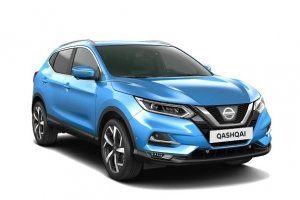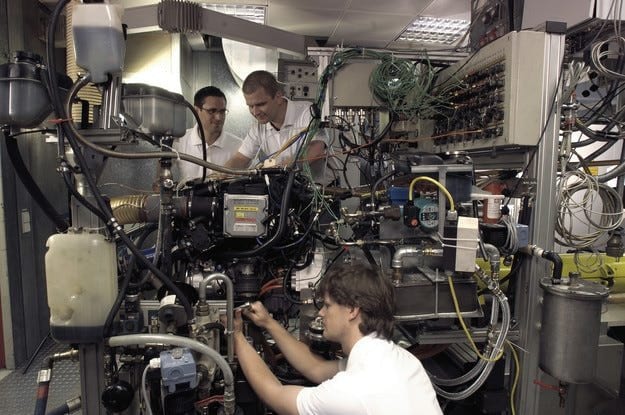
Short test: Nissan Qashqai 1.2 DIG-T Acenta
First of all, Nissan seems to have done a good job with the car's shape already. They didn't take the risk, so it's not as childish as the smaller Juk, but it's different enough from the first generation to make a difference. A very outstanding design, of course, has two sides: some people like this car right away, and some don't like it at all. And they are not even later. Therefore, the shape of the second generation Qashqai is much more refined than the first, it also includes design elements of the house (especially the front and grille) and rear in the style of modern SUVs or those cars that want to be. ... The SUV class was once reserved only for premium SUVs (which it is not), but today it also includes so-called crossovers. Qashqai can be both in appearance and in size.
His decisive movements influence the image of a car that knows what it wants. This is where Nissan's designers should bow and congratulate - it's not easy to make a pretty car, especially if it's supposed to replace the more successful first generation. Well, gold almost never shines, and the Nissan Qashqai is no exception. It was a beautiful sunny day and we used it for our measurements on a few cars, and even before taking the measurements, we agreed with the boys that I would drive the Qashqai after the job was done, which was largely approved by my colleagues. I get behind the wheel and drive away. But when I leave the shadows, I experience a big shock - almost the entire dashboard is strongly reflected in the windshield! Well, in the laundry room they have some merit, as the dashboard was covered in light-shielding, and even more so by Nissan designers and the Japanese tradition of plastic interiors. Of course, this is disturbing, although I believe that a person gets used to it over time, but the solution is definitely not the right one.
The second problem, "provoked" by the Qashqai test, is of course engine related. The downsizing has also affected Nissan, and while the first generation Qashqai has yet to boast high-horsepower engines, the second generation has even smaller engines. Especially the petrol one, only the 1,2-liter engine seems clearly too small even before you hit the gas pedal for the first time. Last but not least, a car as courageous and serious as the Qashqai really doesn't like the engine that started its journey in the little Micra. And one more thought went for mushrooms! The engine is fine unless you buy it to drive the Qashqai, set speed records and save on gas.
With 155 horses and a turbo, you're not the slowest in town, well, not the fastest on the highway. The intermediate route is the most ideal, and driving with a 1,2-liter engine is also more than good in Qashqai on a country road. Of course, it should be borne in mind that the more passengers in the cabin (and any accessories), the faster the ride quality changes and acceleration increases. So, let's put it this way: if you're going to ride mostly solo or in pairs, the 1,2-litre turbocharged petrol engine is perfect for that kind of riding. If you have a long trip ahead of you, even on highways and with lots of passengers, consider a diesel engine - not only for acceleration and top speed, but also for fuel consumption. Because the 1,2-liter four-cylinder is friendly if you're friendly to it, and it can't do miracles during a chase, which is especially evident in its much higher gas mileage.
The rest of the test Qashqai proved to be more than excellent with everything else. The Acenta's package was not the best, but with a few extras, the test car was more than above average. Qashqai also had an optional safety package that includes traffic sign recognition, a warning about moving objects in front of the car, a driver monitoring system, and a parking system.
Nissan seems to have taken care of everything to make the new Qashqai a success. They didn't even exaggerate the price, considering, of course, that compared to the previous generation, the Qashqai is now much better equipped.
Text: Sebastian Plevnyak
Nissan Qashqai 1.2 DIG-T Acenta
Basic data
| Sales: | Renault Nissan Slovenia Ltd. |
|---|---|
| Base model price: | 19.890 € |
| Test model cost: | 21.340 € |
| Calculate the cost of auto insurance | |
| Acceleration (0-100 km / h): | 11,9 with |
| Maximum speed: | 185 km / h |
| Mixed flow ECE: | 5,6l / 100km |
Technical information
| engine: | 4-cylinder - 4-stroke - in-line - turbocharged petrol - displacement 1.197 cm3 - maximum power 85 kW (115 hp) at 4.500 rpm - maximum torque 190 Nm at 2.000 rpm. |
|---|---|
| Energy transfer: | front wheel drive engine - 6-speed manual transmission - tires 215/60 R 17 H (Continental ContiEcoContact). |
| Capacity: | 185 km/h top speed - 0-100 km/h acceleration in 10,9 s - fuel consumption (ECE) 6,9/4,9/5,6 l/100 km, CO2 emissions 129 g/km. |
| Mass: | empty vehicle 1.318 kg - permissible gross weight 1.860 kg. |
| External dimensions: | length 4.377 mm – width 1.806 mm – height 1.590 mm – wheelbase 2.646 mm – trunk 430–1.585 55 l – fuel tank XNUMX l. |
Our measurements
| T = 18 ° C / p = 1.047 mbar / rel. vl. = 63% / odometer status: 8.183 km | |
| Acceleration 0-100km: | 11,9s |
|---|---|
| 402m from the city: | 17,9 years ( 126 km / h) |
| Flexibility 50-90km / h: | 11,8 / 17,5s (IV/V) |
| Flexibility 80-120km / h: | 17,2 / 23,1s (Sun./Fri.) |
| Maximum speed: | 185km / h (WE.) |
| test consumption: | 8,0 l / 100km |
| Fuel consumption according to the standard scheme: | 5,5 l / 100km |
| Braking distance at 100 km / h: | 39,8m |
| AM table: | 40m |
evaluation
The new Nissan Qashqai has grown significantly over its predecessor. It's bigger, maybe better, but definitely better. In doing so, he also flirts with those buyers who did not like the first generation. It will be even easier when a more powerful and, above all, larger gasoline engine becomes available.
We praise and reproach
form
security elements and systems
infotainment system and Bluetooth
well-being and spaciousness in the cabin
quality and precision of workmanship
reflection of the instrument panel in the windshield
engine power or torque
average fuel consumption
